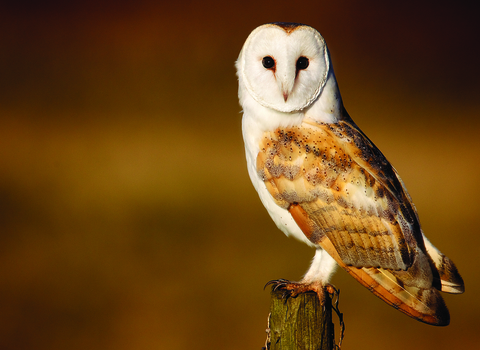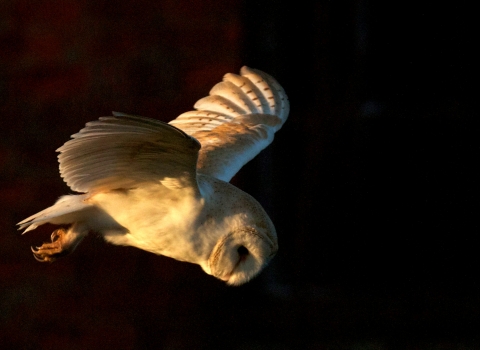Enjoying our barn owl webcam?
Get to know these fascinating birds even better below!

Shutterstock
Featured fact
Did you know...
A barn owl will eat 3 or 4 items of prey every night? During the breeding season, a pair of will find this amount for each owlet as well.
This works out to almost 4,000 prey items a year to feed a pair and their offspring! Farmers looking for rodent control definitely need to put barn owls onto their Integrated Pest management (IPM) list!
Frequently asked questions
Have you given the barn owls names?
The male barn owl we have named Finn. In Irish definitions this means ‘fair’. The male barn owl is typically the lighter in colour of the two (as well as slightly smaller).
Finn's first mate we named Orla. Again in Irish definitions this means golden princess. The female colouring is darker - a more golden hue - with darker rings of colour around the facial disc and more spots on her chest. Finn's current mate is named Trude.
How can I tell which is which?
Adult barn owls are very difficult to tell apart. The female is usually larger than the male and should be slightly darker coloured around the face. Adults are approx. 25cm tall (head to feet) and 33-35cm from top of head to tip of tail. Females also have darker 'bars' on their tail feathers.
Why are they rubbing faces?
During courtship the pair will mutually preen each other and rub cheeks, as well as making soft chittering noises and hissing.
What is all that stuff on the floor of the barn owl box?
They are pellets. The barn owls regurgitate the bits of their meals that they can't digest (bones, fur, etc) into a pellet about the size of man’s thumb.
Why are they eating the pellets?
The female is actually "shredding" the pellets to make a nice soft base for the eggs. The eggs are laid onto whatever surface is available (i.e. wood, loft insulation, stone) dependant on the nest site.
How many eggs will they have? How long until they hatch?
Barn owls usually lay 5 to 6 eggs. The female starts incubating the eggs as soon as the first egg is laid, and lays an egg every 2-3 days. The eggs hatch after 31-32 days incubation, and will hatch in the order they were laid (i.e. 2-3 day intervals).
If they have them, how long will the female brood the eggs/chicks?
The female will continue brooding the young chicks until the eldest is about 3 weeks old. That means she will have been sitting on the nest for a total of nine weeks, and will have relied on her mate for food during all this time.
If they have them, how many chicks will survive?
The number of chicks that survive is directly related to the amount of prey their parents can catch. Things that can affect this are quality of the habitat, how much prey there is in the area, the weather and how experienced the individual parents are.
When would the chicks leave the nest?
Chicks usually start flying at 9-10 weeks, returning to roost for a week or two. They usually start to leave the nest for good when they are about 11-12 weeks. Almost all will have left by 14 weeks.
What do they eat?
Voles, mice and shrews are the most popular prey and are usually swallowed whole. Very occasionally they will eat other food items, but their diet in the UK consists mainly of rodents. In other areas of the world, barn owls are also known to eat amphibians, reptiles, insects, birds, bats, rabbits, earth worms and carrion.
Where is the webcam?
The webcam is situated in a barn owl nest box on a private property in the Blackdown Hills.
I've seen them mating a lot. Why?
As time goes on the male will start bringing the female food and she will spend less and less time hunting. Mating usually occurs each time the male brings the female food prior to egg laying, as part of their courtship.
Are the barn owls affected by the weather?
Yes. It's easier for the barn owls to catch small mammals in dry weather, for two reasons:
- Barn owl feathers are not waterproof so the owls easily become waterlogged in heavy rain, finding it difficult to fly accurately.
- Barn owls rely on their hearing to catch their prey, and rain masks the sound of their prey.
When do they hunt?
Dusk and dawn are the main times for hunting, although they sometimes hunt during the day or at night. It really depends on the individual barn owl, recent weather and how successful hunting has been.
Will barn owls come back to the same nestbox year after year?
Once they have a territory, barn owls tend to use the same nest site year after year and sometimes roost in the nest box over winter to retain the territory.
Where else will barn owls nest?
Nests can be in tree hollows, rock crevices, derelict buildings, barns and nestboxes.
How many barn owls are there in the UK?
There are estimated to be approximately 4,000 pairs of barn owls in the UK.
What noises do barn owls make?
They hiss, screech and shriek. During courtship they also make soft chittering noises as well as hissing. They don't hoot - that's tawny owls.
How can I find out about nestbox cameras?
Please contact our nestbox camera supplier Jason Fathers at Wildlife Windows Ltd or by telephone 01202 461969
I believe a barn owl may be nesting in a structure that is about to be demolished – are they protected?
All birds, their nests and eggs are protected by law: in the UK by the Wildlife and Countryside Act 1981 and in Europe as a whole by The EU Birds Directive (1979). Some birds on Schedule 1 of the Wildlife and Countryside Act (which Barn Owls are) carry very heavy penalties for disturbance etc.
For legal information regarding barn owl nest and roost-sites, please refer to the Barn Owl Trust website: www.barnowltrust.org.uk/barn-owls-law
Answers provided by Somerset Wildlife Trust, Samantha Dallimore, Coastal Centres Officer for Dorset Wildlife Trust, Jason Fathers at Wildlife Windows Ltd and the Barn Owl Trust.










